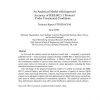Free Online Productivity Tools
i2Speak
i2Symbol
i2OCR
iTex2Img
iWeb2Print
iWeb2Shot
i2Type
iPdf2Split
iPdf2Merge
i2Bopomofo
i2Arabic
i2Style
i2Image
i2PDF
iLatex2Rtf
Sci2ools
86
Voted
MASCOTS
2010
2010
An Analytical Model with Improved Accuracy of IEEE 802.11 Protocol Under Unsaturated Conditions
In this work the authors present an analytical model that -- compared to previously published work -- more accurately captures the delay of IEEE 802.11 protocol under low, medium, and near-saturation load conditions. A Markov chain is used to keep track of the instantaneous number of (active) nodes that have a frame to transmit. The number of active nodes varies over time and is a function of various parameters, including the frame individual maximum retransmission count. One advantage of the proposed analytical model is its ability to estimate the IEEE 802.11 protocol latency and delivery ratio in the presence of quality of service (QoS) classes, each class being defined by a specific maximum retransmission count. Such QoS classes can be adopted to support real time applications for which both latency and delivery ratio must be closely monitored for satisfactory operation. The analytical estimation of these performance parameters may offer useful feedback to admission control schemes...
Analytical Model | IEEE 802.11 Protocol | MASCOTS 2010 | Maximum Retransmission Count | Modeling And Simulation |
Related Content
| Added | 29 Oct 2010 |
| Updated | 29 Oct 2010 |
| Type | Conference |
| Year | 2010 |
| Where | MASCOTS |
| Authors | Kumaran Vijayasankar, Azar Taufique, Lakshmi Narasimhan Kannan, Marco Tacca, Andrea Fumagalli |
Comments (0)

